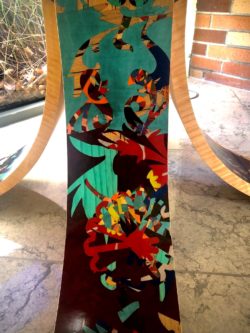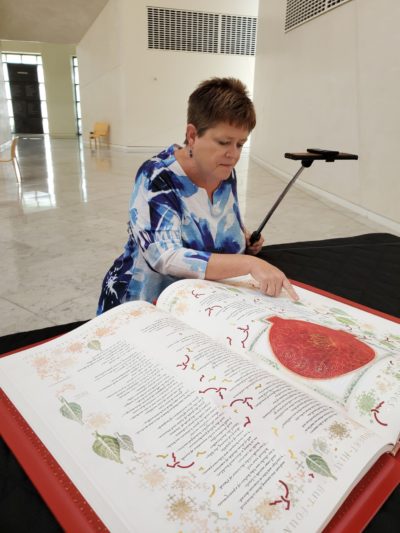At the Fish Interfaith Center at Chapman University, one can participate in a Catholic Mass, enjoy a luncheon with Latter-day Saints, or use the wudu station for ablution before Islamic prayer. The Interfaith Center is just one element of the diversity and inclusion that has been celebrated at Chapman since its founding in 1861. As the University’s website explains, it is “not a Christian college, but a church-related school.” With relationships to both The Christian Church (Disciples of Christ), and The United Church of Christ, the University has “a proud religious heritage, and value[s] the dignity of all people and all religions.”

Now, The Saint John’s Bible Heritage Edition is part of that story at Chapman University. It can be viewed at the Fish Interfaith Center in a sculptural showcase alongside texts including a Torah smuggled out of Lithuania during the Holocaust, an illuminated Koran, an original imprint of the Book of Mormon, and a cabinet housing a replica of the Golden Temple of Sikhism.
The Interfaith Center’s mission is to “provide sacred space and inspire individuals as they shape their spiritual journey,” and the facility’s collection of texts, artistic displays, and multifunctional spaces is available to the University’s more than 10,000 students as they pursue their unique spiritual paths.
From Nebraska to California
Chapman’s path toward acquiring the Heritage Edition actually began 1,600 miles away, at the Joslyn Art Museum in Omaha, Nebraska. In 2006, the Rev. Nancy Brink—now Chapman’s Director of Church Relations—was living in Omaha while the museum hosted “Illuminating the Word,” only the second-ever exhibition of the original bifolia.
“I went to the opening lecture by Donald Jackson there, fell in love with it and joined the museum, and was there every week while it was there,” says Rev. Brink.
In a serendipitious series of events, Brink received trade editions of three of the volumes as a Christmas gift from her father, a retired minister. Years later, after Brink had moved to California and begun her role at Chapman, she invited Dr. Paul Anderson, a visiting professor from George Fox University, to her office. He noticed her trade editions and remarked that George Fox was home to a Heritage Edition.
“I said, ‘What’s the Heritage Edition?’” recalls Brink. “Within the week I was corresponding with Saint John’s.”
Chapman’s initial engagement with the Heritage Edition was through A Year With The Saint John’s Bible, which began in 2019. Rev. Brink used the year as a springboard for fundraising to acquire the complete Heritage Edition, and her drive was fortunately well underway before COVID shutdowns affected the campus. Impressively, the fundraising was completed during lockdown.
A Home Among Art
Brink knew that The Saint John’s Bible would find a warm welcome at Chapman due to the university’s strong commitment to the arts, as well as its foundation in diversity and inclusion. She references the campus art museum, outdoor art collection, and pieces within the Fish Interfaith Center as proof points. “You step on this campus and say, ‘Oh, okay. People care about art here,’” she remarks.
The University is also home to the largest collection of functional art by marquestrist William Tunberg. Among the many pieces of Tunberg art on campus are the sculptural showcases that house the sacred texts and objects in the Fish Interfaith Center. Part of Brink’s fundraising drive to acquire the Heritage Edition was funding for a new display case from the artist to house one volume in the campus library, as well as a Tunberg showcase in the Interfaith Center.
Celebrating Intersectional Identities

Of course, The Saint John’s Bible has far more to offer than aesthetics. “The thing that I just so profoundly love about the Bible—besides its incredible aesthetic appeal—is its social justice message,” says Brink. “All schools are dealing with issues of diversity, but one of the things that we do well at Chapman is that we talk about religious diversity. A lot of places talk about race and gender and disability, but we very consciously have added in religion as one of those intersectional identities, and I think that The Saint John’s Bible has so much to offer in that discussion.”
On the blog for the Fish Interfaith Center, Rev. Brink recently detailed her thoughts on The Saint John’s Bible and its celebration of biblical women; science, technology and discovery; and other world religions.
Recalling how these themes were brought to life at the Interfaith Center prior to lockdown, Brink relates how she often crossed paths with a pair of Muslim students. They were finishing prayers just as she finished a weekly teaching session with one of the volumes. The students began assisting Brink with the large volume, and were curious what it was. As she showed them, she recalls, “We were able to look at how Islam is honored in The Saint John’s Bible. Particularly, I’m thinking about the frontispiece for Matthew and how Hagar is remembered. And they, of course, could read the Arabic and that was incredibly touching. And there are Islamic arabesques that become the light of the menorah. So they were just fascinated by that, at the decorative art that comes from that Islamic tradition.”
Exploring the Art—Together
Having shared the Heritage Edition with classes like graphic design and calligraphy prior to and during lockdown, Brink is looking forward to having students see it in person once again. She made use of a selfie stick to give lessons via Zoom, and was relieved to hear from faculty that the beauty of the volumes still came through.

“They said, ‘You know, this wasn’t too bad!’” she laughs. “The thing we miss is just having people physically gathered around it. The interaction is just so fun. So we are all champing at the bit for classes to come in this fall; I look forward to having seven tables set up so groups can be with each volume to explore it.”
Brink is awaiting final approval to teach an annual interdisciplinary class on The Saint John’s Bible and hopes to co-teach with Director Tim Ternes the first time. “I want to soak up as much of his knowledge so that I can continue to do this on my own into the future,” she says.
In its home at Chapman, those explorations will surely help students and the community celebrate the beauty and diversity the Bible’s creators intended.

